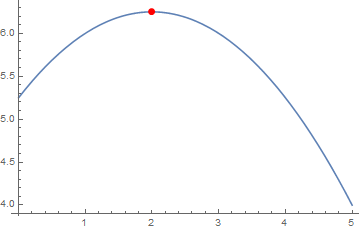sol1[t_?NumericQ] := FindRoot[{a + b - t == 0, a - b - 1 == 0},
{{a, 0.80, 0.95}, {b, 0.95, 2}}];
a0[t_] := sol1[t][[1, 2]];
b0[t_] := sol1[t][[2, 2]];
f[t_] := 5 + a0[t] - b0[t]^2;
Print[sol1[1][[1, 2]]];
max0 := NMaximize[f[t], t];
Print[max0];
max1 := FindMaximum[f[t], {t, 2}];
Print[max1];
Plot[f[t], {t, 0, 5}]
2 Answers
By defining sol1[t_?NumericQ] := you will cause a symbolic argument to be held:
sol1[foo] (* out: sol1[foo] *)
You can therefore not extract parts from it that do not exist. You should therefore make functions that call sol1 also hold symbolic arguments:
ClearAll[a0, b0]
a0[t_?NumericQ] := sol1[t][[1, 2]];
b0[t_?NumericQ] := sol1[t][[2, 2]];
Now symbolic arguments do not evaluate, but numeric ones do:
a0[foo]
a0[3.7]
a0[foo] 2.35
Consider the following rewrite of your code.
Find a generic solution to your system of linear equations:
solution = Solve[{a + b - t == 0, a - b - 1 == 0}, {a, b}] (* Out: {{a -> (1 + t)/2, b -> 1/2 (-1 + t)}} *)Define a function involving those solutions; no need to define it with
SetDelayed(:=) in this case. SimpleSet(=) will do fine here.f[t_] = 5 + a - b^2 /. First@solution (* Out: 5 - 1/4 (-1 + t)^2 + (1 + t)/2 *)Obtain the value of $t$ for which the function $f$ achieves its maximum value. The calculation can be done symbolically:
maximum = ArgMax[f[t], t] (* Out: 2 *)Plot the function
fand the position of the maximum to check:Plot[f[t], {t, 0, 5}, Epilog -> {PointSize[0.02], Red, Point[{maximum, f[maximum]}]} ]

-
$\begingroup$ Thanks for the help. This example represents a much bigger (non-linear) program, and was only meant to show the problem (getting the error messages). Please focus solely on this issue, and not on rectifying the code which is irrelevant per-se! $\endgroup$ Commented Feb 23, 2016 at 7:00

FindRoot[]for a linear equation, y'know. $\endgroup$